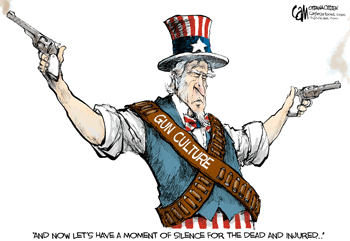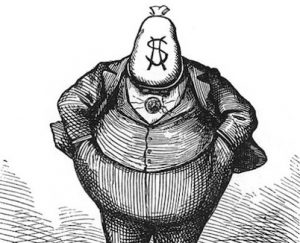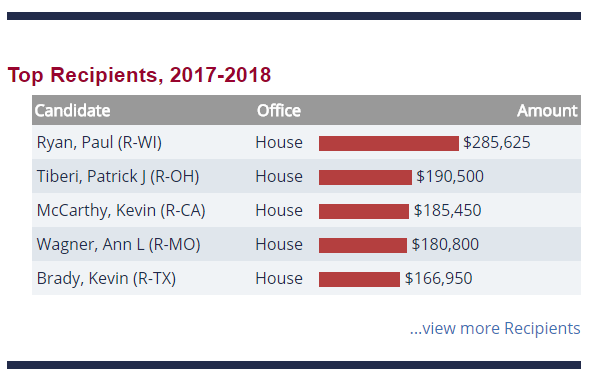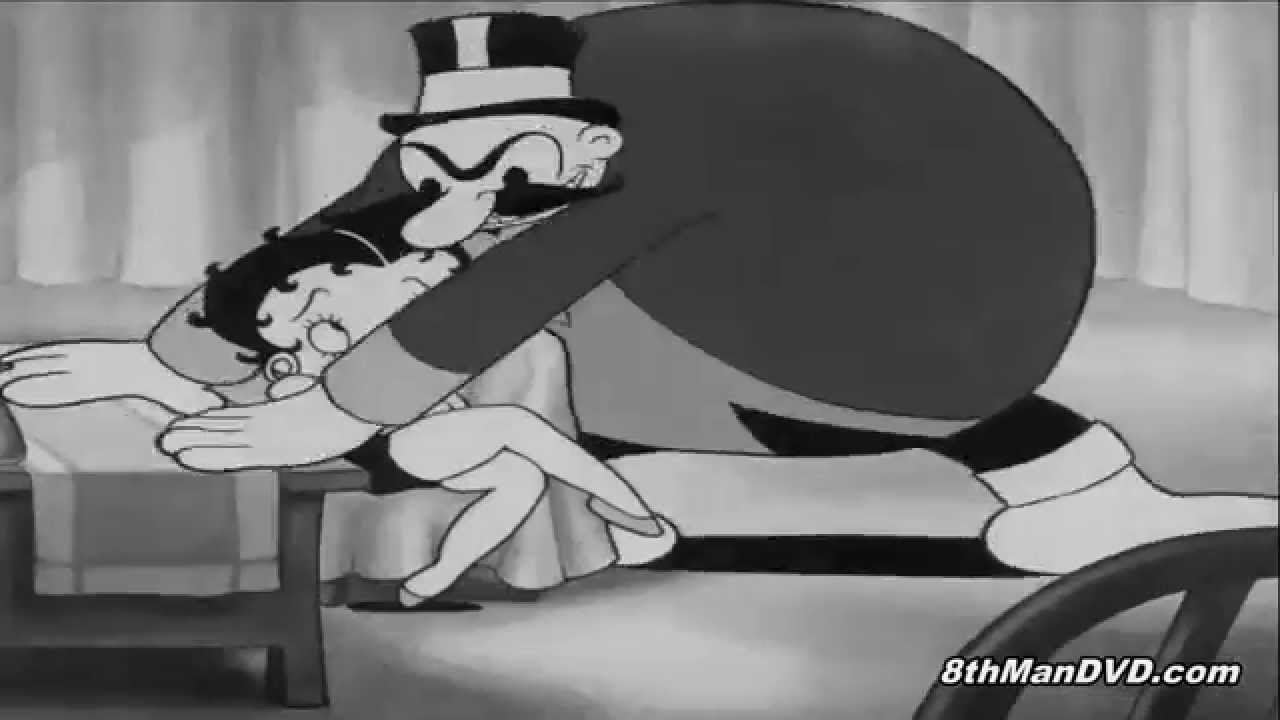Via Josh Marshall, there’s a good article by David Frum on our fruitless gun control debates. Frum points out that the entire debate has been bound by rigid rules that keep us from talking about the central issue, which is that it’s just plain too damn easy to get guns in the U.S.
Americans die from gunfire in proportions unparalleled in the civilized world because Americans own guns in proportions unparalleled in the civilized world. More guns mean more lethal accidents, more suicides, more everyday arguments escalated into murderous fusillades….
… There are subtle, sophisticated, and nuanced approaches to the gun problem that balance the rights of gun owners against the imperatives of gun safety. They may well even make some difference at the margin. But they are unlikely to make any significant difference. Americans debate these approaches not because they are likely to be effective, but because the methods that will work–that have worked in every other advanced society–are here politically taboo.
Was there one legal change that could have thwarted Stephen Paddock? Probably not. But the reason crimes like his are so common here, and so rare in western Europe, is not that we are afflicted with more Stephen Paddocks than they, but because their Stephen Paddocks find it so much more difficult to obtain guns, and especially large quantities of guns.
Another long-time rule is that we’re not allowed to talk about firearms being a problem except in terms of crime. The firearm rights activists always want to turn the conversation around to gang bangers shooting each other in Chicago, or the inner city youth holding up a liquor store to buy drugs. Law-abiding citizens owning guns are not the problem, they say. And the response to that, of course, is that Stephen Paddock was a law-abiding citizen right up to the moment he opened fire.
As Frum points out, we have a lot of different gun problems. The problem of guns used in street crimes and the problem of mass shooters like Stephen Paddock are, in many ways, different problems. The kid who waves a gun to get a clerk to clear out the cash register is not necessarily operating in the same social-psychological space as a guy who hauls an arsenal into a hotel room so that he can kill a lot of strangers from a distance. And we’ve already got a lot of laws to deal with the former problem. It’s the latter problem that is vexing us.
Gun nuttery in general appears to be a culture-bound syndrome in American men, something like the way anorexia nervosa is a culture-bound syndrome in western women. The solution appears to be two-fold — reduce the availability of firearms, and change the culture. Not easy.
I found an article on the evolutionary psychology of mass shootings. Basically, men — younger men, especially — are often driven to displays of violence or risky behavior to “prove” themselves. And guns seems to be a part of that these days.
In 2006 I coauthored a laboratory study on men’s responses to guns in the journal Psychological Science with my colleague Tim Kasser and one of our students. We demonstrated that males who interacted with a handgun showed a greater increase in testosterone levels and more aggressive behavior than males who interacted with the board game Mouse Trap.
In the study, each participant dismantled either a gun or the mousetrap, handled its components and then wrote instructions for how to assemble the objects. Then we gave them the opportunity to put hot sauce into water that was going to be consumed by another person. The participants who handled the gun put in significantly more hot sauce — and were also more likely to express disappointment after learning that no one was going to actually drink the concoction.
Thus, cues tied to threats often won’t result in aggressive responses unless testosterone is involved. Elliot Rodger, the disturbed college student whose violent 2014 rampage through Santa Barbara, California, was foretold in a chilling YouTube video, clearly experienced a testosterone surge upon purchasing his first handgun.
“After I picked up the handgun,” he explained, “I brought it back to my room and felt a new sense of power. Who’s the alpha male now, bitches?”
So, yeah, as we all have pretty much figured out by now, the guy who strolls the aisles of Home Depot with an SIG SG 550 strapped on probably has masculinity issues. But the mass shooter has other problems.
British clinical psychologist Paul Gilbert has developed something he calls the Social Attention Holding Theory. According to Gilbert, we compete with each other to have other people pay attention to us; when other people take notice, we build status. The increased status that comes from having others attend to us leads to all kinds of positive emotions. But persistently being ignored by others produces much darker emotions — especially envy and anger.
It’s no mystery why the media will often describe mass shooters and terrorists as misfits or loners. In many cases, they are. …
… Apparently, a lack of attention from others results in a lack of status, resulting in a lack of access to women. Combined with a young man’s testosterone, it creates a toxic, combustible mix.
There may not be much we can do to change the structure of the young male mind that evolved over the course of millions of years. However, ignoring or denying its existence doesn’t do us any favors.
Stephen Paddock was not young, but by all accounts he was very much a loner, pathologically so.
The author also discusses men who join terrorist organizations:
Nicolas Henin was a Frenchman who was held hostage by ISIS for ten months. Here’s how he described his young, murderous, Jihadi captors:
They present themselves to the public as superheroes, but away from the camera are a bit pathetic in many ways: street kids drunk on ideology and power. In France we have a saying — stupid and evil. I found them more stupid than evil. That is not to understate the murderous potential of stupidity.
Is there any motivational difference between why one youth joins ISIS and another joins an inner-city gang? Possibly not. It’s probably the same damn syndrome expressing itself in culturally different ways.
So what are we gonna do?
The good news is that the rate of Americans who own guns has actually been going down over the past several years. In 1994, 53 percent of American households had at least one firearm. In 2016, it was 36 percent. So we aren’t all guns nuts on this bus.
Put another way — 78 percent of Americans own no guns. However, just 3 percent of Americans own 50 percent of the guns in the U.S. And there probably are more guns in circulation in the U.S. than there are people.
Further, — the U.S. has 4.4 percent of the world’s population but contains nearly half of the world’s privately owned firearms.
Just try to get a gun nut to address those numbers. Can’t be done. It’s not the gun, it’s the person, they’ll tell you. But it’s the person who can easily get guns that perpetrate mass shootings. As David Frum said,
Was there one legal change that could have thwarted Stephen Paddock? Probably not. But the reason crimes like his are so common here, and so rare in western Europe, is not that we are afflicted with more Stephen Paddocks than they, but because their Stephen Paddocks find it so much more difficult to obtain guns, and especially large quantities of guns.
As I’ve written before, owning six or more firearms is an indicator a person is likely to be violent.
Josh Marshall:
Guns have been embedded in American culture, particularly though not exclusively rural culture, for centuries. But what we might call extreme gun ownership—individuals owning large numbers of often quasi-military firearms — is quite new. The mass casualty shooting is no longer a random freak out by a troubled person: it’s an established American idiom of violence, a way certain people choose to make a statement to the society at large.
We absolutely must address the issue of extreme gun ownership. We can make a distinction between the extreme gun owner and the antique firearm collector, but otherwise we must have limits on how many firearms a person can legally own at one time. And that’s going to require registrations and a database to keep track of such things, and the firearm activists will hate it. And I’m sure a lot of them will become criminals to keep their arsenals. But it’s got to be done to even begin to get a handle on the mass shooting problem.
Another point made by Josh Marshall last week is that we need to “de-normalize” firearms and the open carrying of firearms. We should not accept or just get used to the sight of civilians strolling around with firearms.
It may be the case that the specific open carry ‘activist’ probably isn’t going to aim his AR-15 at the restaurant crowd and start shooting. But guns are inherently dangerous and especially so in civilian spaces. Normalizing them in this way is dangerous and part of the problem. This cultural component is as critical as the legal restrictions. But we are not collectively powerless in the face of culture. We know this from the evolution of perceptions of drunk driving, smoking, domestic violence and numerous other de-valorized activities. We reify cultural norms in laws and laws, along with the behaviors they shape in turn, changes culture.
If we could get across the perception that a firearm does not make you the “alpha male” and instead is a badge of weakness, we might get somewhere. I’m not sure how that will be accomplished, though.






